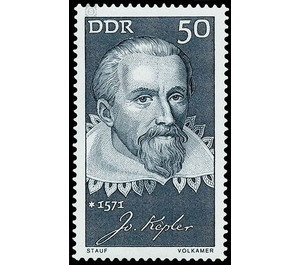Commemorative stamp series - Germany / German Democratic Republic 1971 - 50 Pfennig
Theme: Astronomy & Space
| Country | Germany / German Democratic Republic |
| Issue Date | 1971 |
| Face Value | 50.00 |
| Color | black |
| Perforation | K 14 |
| Printing Type | Typography |
| Stamp Type | Postage stamp |
| Item Type | Stamp |
| Chronological Issue Number | 1391 |
| Chronological Chapter | GER-DDR |
| SID | 141409 |
| In 24 Wishlists | |
Important Personalities, Edition 1971 The Ministry of Posts and Telecommunications of the German Democratic Republic publishes six special postage stamps with illustrations of important personalities. No special first-day cover letter DDR honors important scientists, writers and artists JOHANNES KEPLER was born on 27 December 1571 in Weil. He died on November 15, 1630 in Regensburg. In addition to Copernicus, Galileo and Newton Kepler belongs to the great founders of modern astronomy and physics. By determining the planetary orbits and discovering the mathematical laws of planetary motion, he gave the worldview of Copernicus a solid foundation. At the same time he created conditions for the pioneering discovery of the law of gravitation by Newton. As a teacher of the pen school in Graz, Kepler finally turned to astronomy. In his first astronomical work, "Mysterium Cosmographicum" (World Secrets), he sets out to investigate the "cause of the number, the size and the motion of the planetary orbits". From 1600 to 1601 Kepler, expelled from Graz as a Protestant, worked in Prague with the great astronomer Tycho Brahe; after his death as Imperial mathematician Rudolf II in Prague and Linz (1612-1626). Access to Brahe's extensive observational material provided him with possibilities for the calculation of the planetary orbits and the formulation of the orbits of planets (3 Kepler's Laws 1605, 1609, 1618). With the erection of the 3rd Kepler's Law (World Harmony 1619) he manages to establish the connection between the orbit sizes of different planets. In addition to his research on the planetary system are works on optics (instruments and Sehvorgang 1604, astronomical telescope 1611), conic sections, the barrel theory and studies on regular polygons. In 1627, the crowning glory of his work was the Rudolfine Tables, which for more than a century remained the basis for all astronomical calculations in the solar system.


